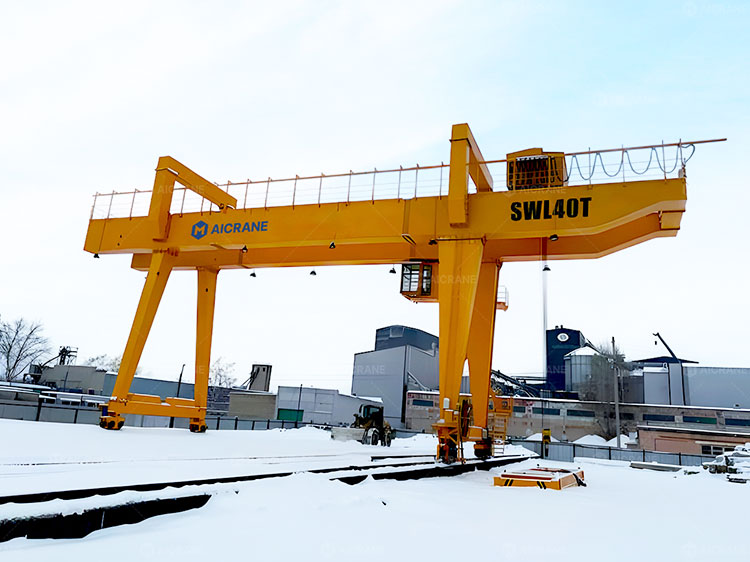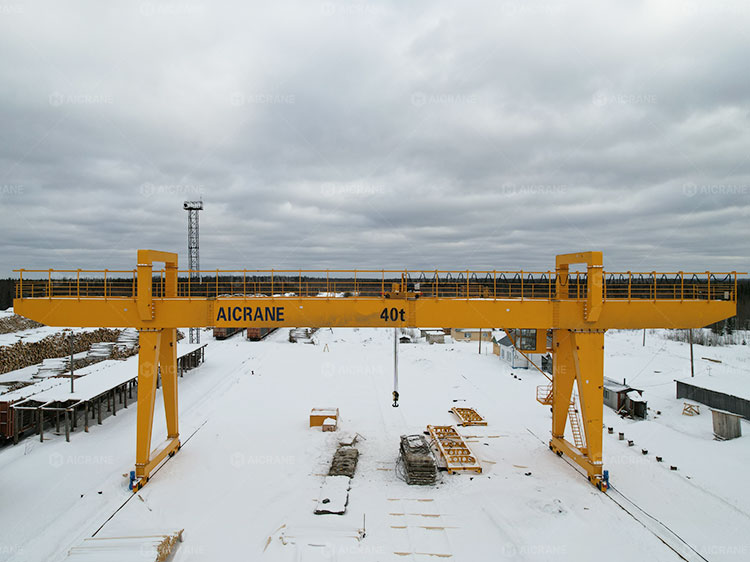A 40-ton gantry crane is a powerful tool in modern industrial operations, capable of handling heavy loads with precision. However, while lifting capacity is often the focus when selecting a gantry crane, lifting height is an equally critical factor that significantly affects overall performance, operational efficiency, and safety. Understanding how lifting height impacts a 40-ton gantry crane can help plant managers, engineers, and operators optimize crane usage and ensure long-term reliability.

Understanding Lifting Height in Gantry Cranes
Lifting height, also called the hook height or underhook height, refers to the maximum vertical distance a crane’s hook can travel from the ground or the crane rail. It is a key specification in any gantry crane design because it determines how high materials can be lifted and positioned during operations. For a 40 ton gantry crane, lifting height is influenced by several design parameters, including the hoist type, trolley design, girder height, and overall crane structure.
The lifting height is not only a measurement of vertical travel but also a factor that influences mechanical load distribution, stability, and cycle times. When the lifting height is increased, certain operational characteristics and design requirements must be carefully considered to maintain optimal performance.
Impact on Hoist and Trolley Performance
The hoist is the component responsible for lifting and lowering loads, and its performance is directly tied to the lifting height. For a 40-ton gantry crane, increasing lifting height can have the following effects:
-
Hoist Rope Length: Greater lifting heights require longer hoist ropes or chains. Longer ropes increase the weight of the lifting system itself, adding to the total load on the hoist motor and the crane structure. This additional load can reduce lifting speed and increase power consumption.
-
Motor Sizing: The hoist motor must be adequately sized to handle not only the rated load of 40 tons but also the additional resistance caused by longer rope lengths and higher lift. Underestimating this can lead to motor overheating, reduced service life, and potential operational failures.
-
Trolley Travel Dynamics: On double girder gantry cranes, the trolley moves along the bridge girders to position loads. A higher lifting height may result in more sway during trolley movement, especially when transporting the load across longer spans. The trolley system must be designed to minimize sway and ensure precise load positioning, which is critical for safety and efficiency.
Structural Considerations for High Lifting Heights
As lifting height increases, the structural demands on the gantry crane also rise. The bridge girders, end beams, and supporting columns must withstand higher bending moments and stresses caused by elevated load positions.
-
Bridge Girder Strength: At higher hook positions, the lever effect on the crane’s main girder is amplified. This requires girders with greater moment of inertia to resist bending and deflection. Without proper design, excessive deflection can cause uneven trolley movement, increase wear on wheels, and compromise load stability.
-
Column and Support Integrity: Gantry crane columns must handle both vertical loads and lateral forces. Lifting a 40-ton load to a higher position increases the potential for lateral sway, especially in outdoor applications exposed to wind. Stronger, well-braced columns are essential to prevent structural fatigue over time.
-
Foundation Requirements: Higher lifting heights can transmit greater dynamic loads to the crane’s supporting foundation. Concrete footings or rails must be designed to absorb these forces without settlement, ensuring long-term operational reliability.

Effects on Load Handling and Safety
The lifting height directly influences the handling of heavy loads. Higher lifts introduce more opportunities for instability, which can affect both safety and operational efficiency.
-
Load Sway: As the hook rises, even small movements in the trolley or bridge can create pronounced load swing. Excessive sway can lead to collisions with nearby structures or equipment, risking damage to both the load and the overhead gantry crane. Anti-sway mechanisms, such as mechanical dampers or electronic sway control, become more critical at higher lifting heights.
-
Stopping Distance: The higher the load, the greater the potential energy. This increases the stopping distance required when lowering or positioning the load. Operators must account for this in operational planning, and automated braking systems are often recommended to enhance safety.
-
Visibility and Control: Lifting a 40-ton load to higher positions can reduce the operator’s line of sight, especially in large warehouses or outdoor yards. This makes precise placement more challenging, necessitating camera systems, remote control, or spotter assistance for accurate load handling.
Energy Consumption and Operational Efficiency
Lifting height also affects the energy efficiency of a 40-ton gantry crane. Higher lifts require more motor power to overcome gravity, increasing energy consumption. Additionally:
-
Cycle Time: Longer lifting distances increase the time required for each load movement. This may reduce overall throughput, particularly in high-volume operations. Optimizing lifting height according to operational needs ensures that the crane performs efficiently without unnecessary delays.
-
Maintenance Intervals: Frequent lifting to maximum heights places additional stress on hoist components, wire ropes, and mechanical joints. Maintenance schedules must consider the impact of high-lift operations to prevent premature wear and avoid unexpected downtime.
Design Solutions for High Lifting Heights
Manufacturers of 40-ton gantry cranes offer several design solutions to mitigate performance issues associated with increased lifting heights:
-
High-Capacity Hoists: Using hoists specifically designed for high-lift applications ensures reliable performance, faster lifting speeds, and longer service life.
-
Reinforced Structural Components: Reinforced girders, columns, and end beams help manage higher bending moments and lateral forces.
-
Advanced Control Systems: Anti-sway technology, load positioning sensors, and automated braking systems improve precision and safety, particularly at greater heights.
-
Optimized Rope Management: Multi-layer drum hoists or specialized wire rope configurations reduce rope fatigue and improve lifting stability.
-
Operator Training: Operators should be trained to handle high-lift operations safely, including managing load sway, maintaining clear sightlines, and understanding crane dynamics at maximum hook heights.
Practical Considerations for Industrial Applications
When specifying a 40-ton gantry crane, it is essential to match lifting height requirements with actual operational needs. Overestimating lifting height can unnecessarily increase costs and complicate design, while underestimating may limit functionality and reduce productivity.
For example:
-
In a precast concrete yard, lifting heights may need to accommodate stacking multiple beams or panels.
-
In a shipyard, high lifts may be required to install heavy components at elevated positions on vessels.
-
In manufacturing or warehouse environments, lifting height must align with the clearance of other equipment and racking systems.
Balancing lifting height with gantry crane capacity, span, and operational environment ensures that the 40-ton gantry crane performs efficiently, safely, and reliably.
Conclusion
Lifting height is a critical factor that directly impacts the performance of a 40-ton gantry crane. From hoist motor sizing to structural design, load handling, safety, and energy efficiency, every aspect of crane operation is influenced by how high it needs to lift a load. By carefully considering lifting height during the design and selection process, industries can optimize crane performance, minimize maintenance costs, and maintain safe, efficient operations.
Whether for precast concrete handling, heavy equipment installation, or general industrial applications, understanding the relationship between lifting height and crane performance allows operators and engineers to maximize the potential of their 40-ton gantry cranes while ensuring safety and longevity.
